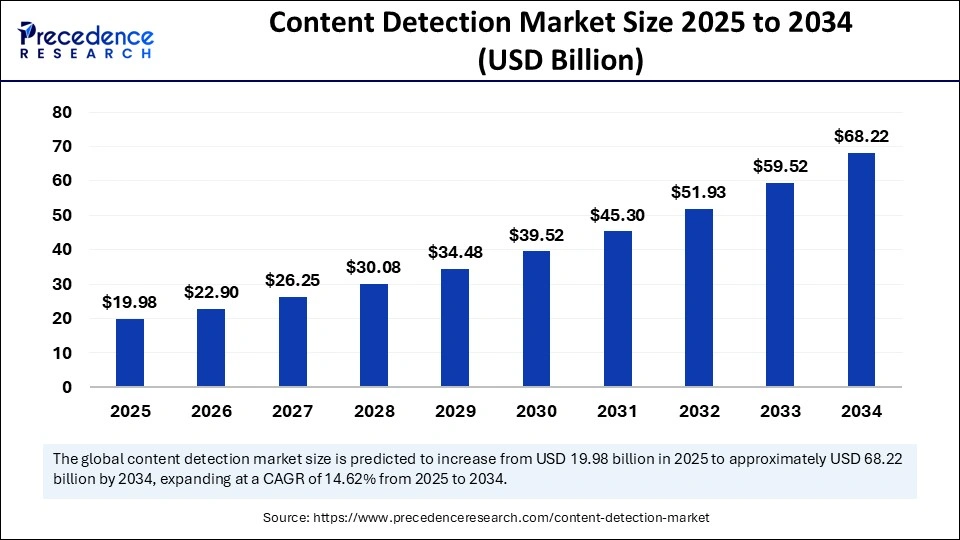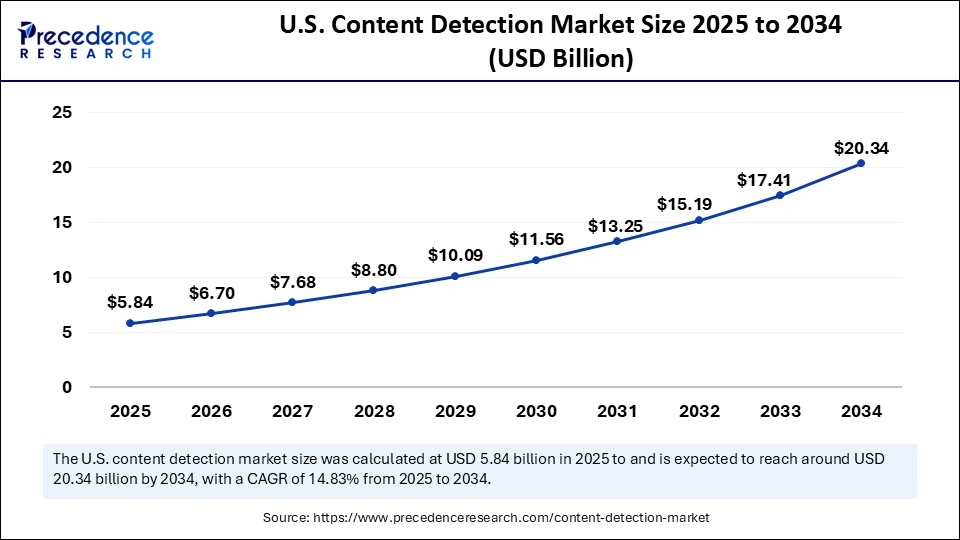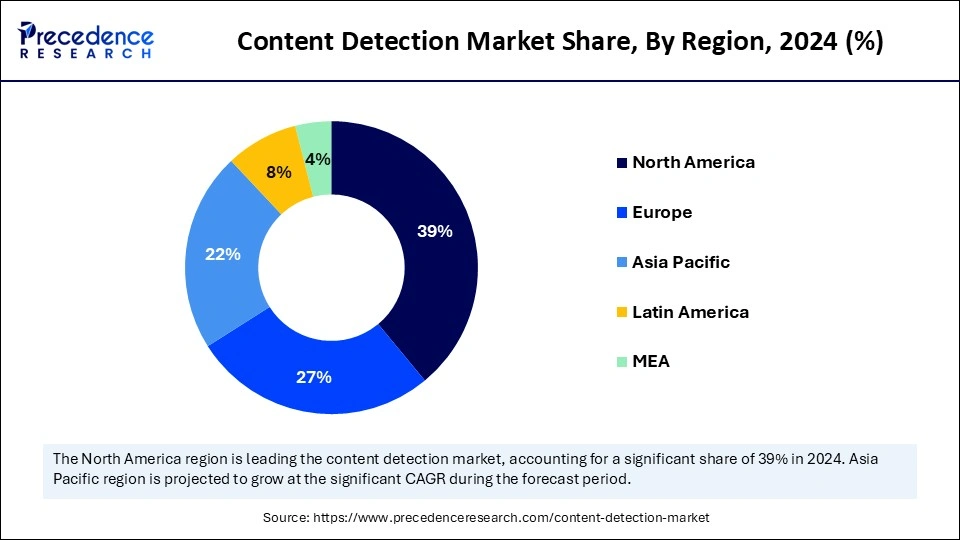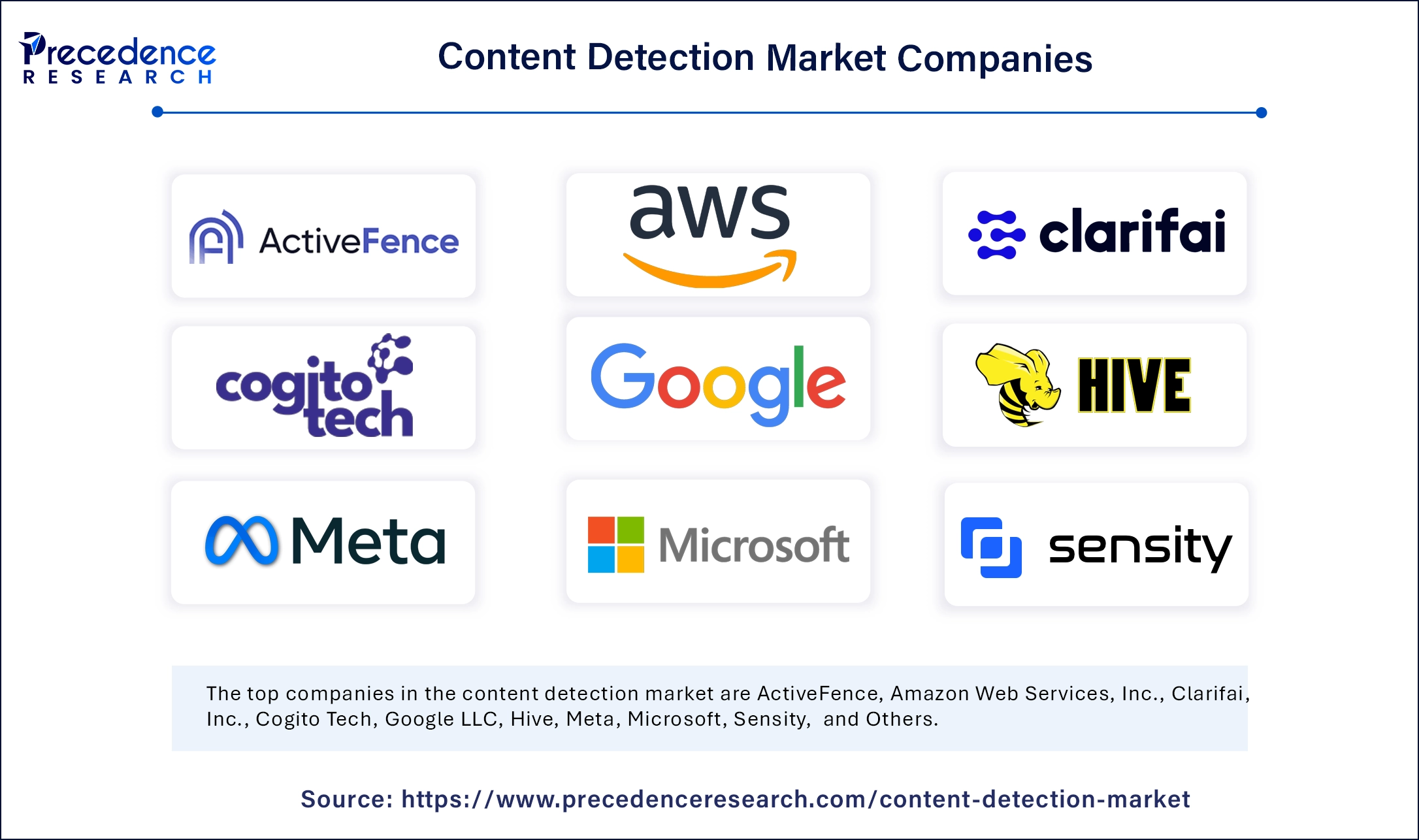List of Contents
What is the Content Detection Market Size?
The global content detection market size accounted for USD 19.98 billion in 2025 and is predicted to increase from USD 22.90 billion in 2026 to approximately USD 68.22 billion by 2034, expanding at a CAGR of 14.62% from 2025 to 2034. The growth of the market is driven by the rising concerns about safety and security of digital content.

Content Detection Market Key Takeaways
- North America dominated the content detection market with the largest share of 39% in 2024.
- Asia Pacific is expected to grow at the fastest CAGR during the forecast period.
- By detection approach, the content moderation segment held the biggest market share of 55% in 2024.
- By content type, the text segment dominated the market in 2024.
- By end use, the social media platforms segment led the market in 2024.
Artificial Intelligence: The Next Growth Catalyst in Content Detection
Artificial Intelligence (AI) is pushing companies that provide content detection solutions to enhance and strengthen their existing detection strategies. Generative AI platforms are being widely utilized to generate content, which needs to be effectively tackled to avoid the spread of fake or any misinformation. AI technology is rapidly being integrated into content detection systems to enhance content detection. With AI-driven tools, real-time monitoring and moderation are possible, helping the teams make quick as well as informed decisions. Integrating AI technology in content detection software can improve the system for advanced and emerging threats, helping enhance the efficiency and functioning of these detection tools. Key players in this market are adopting AI technology in various capacities to help boost the reliability and efficiency of the existing content detection infrastructure. AI content, deepfakes, misinformation, etc., have become a part of the digital space; utilizing AI technology for moderation and detection of such information will aid the growth of this market in the coming years.
- In June 2024, a leading AI content detection platform, GPTZero, announced that it had received USD 10 million in a Series A funding round. This funding will go towards revolutionizing the adoption of AI in a responsible way on their platform.
Strategic Overview of the Global Content Detection Industry
Content detection consists of the identification, classification, and analysis of different types of content like text, videos, images, and audio using advanced technologies. Content detection tools can identify specific keywords, patterns, or elements in the data to ensure that the compliance guidelines of the platform are met. The rising concerns regarding the safety of online content because of misinformation, inappropriate language, and abusive behavior have made it essential for organizations to invest in content moderation. The utilization of such tools helps businesses remove and flag content that does not comply with their platform guidelines, ensuring a safer space for consumers.
Governments and other regulatory agencies are making efforts to protect data and tackle the challenge of unsuitable online behavior. The stricter compliance requirements regarding the moderation of content are a major factor supporting this market's growth. With advancements in technology, it has become easier to integrate AI, NLP, and ML into content detection tools. The integration of such technologies is helping enhance the precision and efficiency of content detection of these tools. The research and development efforts are ongoing by the key players that will further help improve the functioning of such tools and aid the growth of this market.
Market Outlook
- Market Growth Overview: The Content Detection market is expected to grow significantly between 2025 and 2034, driven by advances in AI and machine learning, real-time moderation, and the emergence of new technologies.
- Sustainability Trends: Sustainability trends involve mitigating algorithmic bias, transparency and explainable AI, and ethical adults and third-party oversight.
- Major Investors: Major investors in the market include Microsoft, Google, Amazon, Venture Capital Firms, DCVC, and Huddle Ventures.
- Startup Economy: The startup economy is focused on developing specialized AI tools for content verification, using AI and ML to offer platform-specific and niche content moderation, and creating a direct-to-consumer solution for writers and content producers.
Content Detection Market Growth Factors
- The growing necessity for online platforms to help manage harmful content is a key factor driving the growth of the content detection market.
- The rising awareness amongst organizations and people for online safety is fueling the demand for content detection tools, aiding market growth.
- The increasing volume of user-generated content and its use for various purposes is boosting the growth of this market.
- Integration of advanced technologies like AI and ML is improving the accuracy and reliability of content detection tools, supporting market growth.
- Stringent regulations regarding data safety and privacy further boost the growth of the market.
Market Scope
| Report Coverage | Details |
| Market Size by 2034 | USD 68.22 Billion |
| Market Size in 2025 | USD19.98 Billion |
| Market Size in 2026 | USD 22.90 Billion |
| Market Growth Rate from 2025 to 2034 | CAGR of 14.62% |
| Dominated Region | North America |
| Fastest Growing Market | Asia Pacific |
| Base Year | 2024 |
| Forecast Period | 2025 to 2034 |
| Segments Covered | Detection Approach, Content Type, End Use, and Region |
| Regions Covered | North America, Europe, Asia-Pacific, Latin America and Middle East & Africa |
Market Dynamics
Drivers
Increasing Volume of User-generated Content
The increasing volume of user-generated content across different platforms is a key factor driving the growth of the content detection market. The constantly increasing volume of user-generated data, especially through social media and e-commerce, is creating the need for effective content detection tools. A rise in user-generated data has also raised concerns about misinformation and inappropriate comments, leading to the adoption of content moderator tools. The increase in accessibility and availability of the internet across the world has led to the widespread generation of user data on a regular basis. Marketing teams of various businesses often utilize strategies requiring user-generated data, positively impacting market growth. For instance, nearly 90% of consumers share their experience about a brand or product on social media. This shows that user-generated content is important for marketing and requires content detection. Various brands are focusing on user-generated content for marketing and advertising, which further drives the growth of the market.
Restraint
Data Privacy Concerns
Concerns regarding data privacy are rising all over the world, which is limiting the growth of the content detection market. The worries about misuse of personal data in the digital space are a big concern amongst the population. For example, 75% of adults in Spain and the UK feel that tech companies have too much control over their personal data. This has led to stricter regulatory frameworks to improve data privacy. Creators worry that their original and personal content can be stored and then used through content detection tools, which hinders the expansion of this market. Key players in this market must work on enhancing the security of their data collection tools to comply with stricter data privacy laws and ensure consumer trust.
Opportunity
Demand for Real-time Moderation
There is a growing need for proper moderation solutions in content detection. The rise in demand for real-time moderation offers the content detection market a new opportunity for innovation and expansion. An exponential increase in content on various social media platforms has led to increased misinformation, hate speech, and inappropriate and harmful content being posted on a daily basis. Integrating real-time moderation can help curb the spread of such misinformation and abusive content on online platforms. This helps in safeguarding and ensuring that these platforms' content guidelines are being met. Integration of advanced technologies like automation, AI, and machine learning (ML) can help in real-time monitoring of content.
Detection Approach Insights
The content moderation segment led the content detection market with the largest share in 2024. The rise in the spread of harmful, fake, and misleading information created the need for proper content moderation. Content moderation systems are being widely used across different industries to identify unsuitable and harmful content, such as text, videos, images, and livestreams. Technological improvements have enhanced the reliability and accuracy of content moderation solutions, reinforcing the long-term growth of the segment.
Meanwhile, the AI content verification segment is expected to grow at a significant rate during the forecast period. The rising concerns of false information and deepfakes are encouraging organizations to integrate AI content verification tools to verify the information. With the rising volumes of content generation in the digital landscape, the implementation of AI models in content detection tools is rising, driving the growth of this segment.
Content Type Insights
The text segment dominated the content detection market in 2024. There is an exponential rise in text content across different platforms, such as news outlets, social media, blogs, and online forums. This has directly increased the volume of misinformation, inappropriate language, and spam content, which created the need for text moderation. Technological innovations like Natural Language Processing (NLP) have helped improve the efficiency and effectiveness of content detection tools in detecting text. With a constant rise in text content globally, the segment is likely to continue its growth trajectory.
On the other hand, the video segment is likely to expand at a significant growth rate in the upcoming period. The use of deepfake technology and synthetic media on a wide scale has raised concerns regarding false information spread through videos. The increasing need for real-time moderation for detecting videos on streaming and social media platforms contributes to the growth of the segment.
End Use Insights
The social media platforms segment led the content detection market in 2024. This is mainly due to the rapid increase in the use of social media platforms across the world. This has led to the rapid spread of misinformation among the masses. Social media platforms have been investing regularly in improving content detection and moderation technologies to limit the spread of false and inappropriate information. The increased need for real-time monitoring as well as AI-driven automation to manage the massive influx of content further bolstered the segment's growth.
Meanwhile, the media streaming & sharing services is expected to expand at the fastest rate during the forecast period. The growth of the segment is attributed to the increasing use of streaming services. It is necessary for streaming platforms to invest in advanced content detection tools in order to manage the content, protect copyrights, and identify inappropriate content. Regulatory agencies are pushing streaming companies to manage the content properly and detect misinformation, significantly driving the growth of the segment.
North America held the largest share of the content detection market in 2024
This is mainly due to the heightened usage of digital content across various industries. With the advanced digital ecosystem, North American businesses have increased their investments in the last few years in sophisticated content detection tools to manage misinformation and reduce the risk ofsecurity threats. There is a significant rise in the adoption rate of advanced technologies in the digital space. The region is home to some of the leading tech companies that are responsible for content generation, significantly boosting the demand for content detection and moderation tools. The region has a high rate of adoption of digital technologies in different industries like education, media, and finance, which further bolstered the growth of the market in the region.
U.S. Content Detection Market Size and Growth 2025 to 2034
The U.S. content detection market size is evaluated at USD 5.84 billion in 2025 and is projected to be worth around USD 20.34 billion by 2034, growing at a CAGR of 14.83% from 2025 to 2034.

Asia Pacific is projected to experience the fastest growth during the forecast period. The rapid pace ofdigital transformation in the region and the rising accessibility and availability of internet services are major factors driving the growth of the market in the region. The rising popularity of social media platforms significantly drives the market's growth. According to a recent report, as of now, there are 2.5 billion active social media users in Asia Pacific, with 97.3% of the population accessing social media platforms regularly. This, in turn, generates large volumes of data, ultimately boosting the need for content detection and moderation solutions. Governments around the region have imposed stringent regulations on the spread of misinformation, contributing to market growth.

India Content Detection Market Trends
India's focus on multilingual and real-time moderation, as well as the proliferation of social media, e-commerce, and OTT platforms, is a major driver of the content detection market in India, with companies investing in effective user-generated content management. Emphasis on services and solutions, with the presence of both domestic and international players.
Europe is considered to be a significantly growing area
The growth of the content detection market in Europe can be attributed to stringent regulations regarding the privacy and security of digital content. The increasing volumes of user-generated content and the proliferation of social media platforms significantly drive the market's growth. The rising awareness among the population about misinformation and media manipulation led to increased adoption of content detection tools.
Germany Content Detection Market Trends
Germany's content detection market is in demand for AI-driven, multilingual content moderation solutions across various digital platforms. The market is primarily shaped by stringent EU regulations like the AI Act and a strong emphasis on data privacy under GDPR. Companies are focusing on real-time, automated systems to manage the explosion of user-generated content while navigating the complex regulatory landscape.
Value Chain Analysis of the Content Detection Market
- Content Creation & Aggregation
At this foundational stage, digital content is generated by individuals and organizations across platforms like social media, e-commerce sites, and online gaming platforms.
Key Players: Meta and Google. - Data Curation & Annotation
Raw data must be processed and labeled to train and refine AI content detection models. This stage involves identifying and tagging inappropriate content with human expertise, a task that requires both nuanced judgment and scalability.
Key Players: Cogito Tech - Technology Development & Solution Provision
This stage involves the R&D and engineering required to build the actual content detection software and platforms using AI, ML, and other technologies.
Key Players: Clarifai, Inc., Hive, and ActiveFence. - Infrastructure and Deployment
The content detection solutions need powerful and scalable infrastructure to operate effectively, particularly for real-time moderation of massive data streams.
Key Players: Amazon Web Services (AWS) and Microsoft - Service Provision & Integration
Once the core technology is developed and hosted, it needs to be integrated into the operations of platforms or provided as a managed service.
Key Players: Wipro
Top Companies in the Content Detection Market & Their Offerings:

- ActiveFence contributes to the content detection market by offering a trust and safety platform that helps enterprises and platforms manage harmful online content across various channels. They provide a range of solutions, including content monitoring, threat intelligence, and automated moderation tools, to keep platforms safe.
- Amazon Web Services, Inc. (AWS) plays a crucial role by providing the cloud infrastructure and AI/ML services that power many content detection solutions and platforms globally. Their services enable efficient and scalable storage, processing, and analysis of vast amounts of data required for content moderation.
- Clarifai, Inc. contributes through its powerful AI platform, which provides advanced visual recognition and natural language processing capabilities for automated content analysis. Their technology helps businesses detect and moderate a wide array of harmful or inappropriate content at scale.
- Cogito Tech provides human-in-the-loop services for data annotation and content moderation, offering the nuanced judgment that automated systems often lack. Their trained workforce helps to refine AI models and ensure high accuracy in detecting complex or context-specific harmful content.
- Google LLC is a major player, contributing to the content detection market through its extensive research in AI and ML, which powers advanced content filtering on its platforms like YouTube and Search. They also provide businesses with AI solutions via Google Cloud, including content moderation APIs and technologies like Vision AI.
Hive contributes through its leading cloud-based AI solutions for understanding and moderating content at scale across various modalities, including text, image, video, and audio. They work with a wide range of companies to help them manage user-generated content and maintain platform safety efficiently. - Meta (formerly Facebook) is a significant contributor due to its heavy investment in cutting-edge AI research and development for content moderation on its social media platforms, including Facebook, Instagram, and WhatsApp. Their technology and operational scale drive innovation in the field, helping to set industry standards for managing vast amounts of user-generated content.
- Microsoft provides enterprise-level content detection solutions through its Azure AI services, offering tools like Content Moderator and Azure AI Vision for automated content analysis. They also heavily invest in cybersecurity and trust & safety initiatives, helping businesses protect their brand and users from online harm.
Sensity specializes in the detection of manipulated media and deepfakes, providing an important service in the evolving landscape of digital misinformation. Their technology helps platforms and businesses identify and address sophisticated, AI-generated synthetic content that poses significant security and trust challenges. - Wipro contributes to the content detection market as a major IT consultancy and services provider, offering managed content moderation services and developing custom AI solutions for its clients.
Recent Developments
- In April 2025, an Israel-based company, AI Light developed a tool that helps in detecting AI-generated images, text, and videos.
- In November 2024, an award-winning deepfake detection platform, Reality Defender entered into a partnership with TaskUs, a well-known outsourced digital services and next generation customer experience company. The partnership allows TaskUs content moderation teams to maintain platform integrity, safeguard communities, and flag harmful content with Reality Defender's robust AI detection tools.
Segments Covered in the Report
By Detection Approach
- AI Content Verification
- Content Moderation
- Plagiarism Detection
By Content Type
- Text
- Image
- Audio
- Video
By End Use
- Social Media Platforms
- Media Streaming & Sharing Services
- Retail & E-commerce
- Gaming Platforms
- Others
By Region
- North America
- Europe
- Asia Pacific
- Latin America
- Middle East & Africa (MEA)
For inquiries regarding discounts, bulk purchases, or customization requests, please contact us at sales@precedenceresearch.com
Frequently Asked Questions
Ask For Sample
No cookie-cutter, only authentic analysis – take the 1st step to become a Precedence Research client



